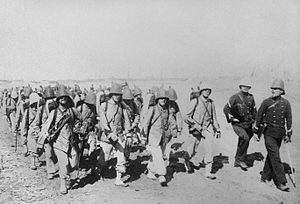Second Madagascar expedition
| Second Madagascar expedition (1894-95) |
|||||||
|---|---|---|---|---|---|---|---|
| Part of the Franco-Hova Wars | |||||||
 French infantry landing at Majunga, May 1895. |
|||||||
|
|||||||
| Belligerents | |||||||
|
|
|
||||||
| Commanders and leaders | |||||||
|
|
|
||||||
| Strength | |||||||
| 15,000 men 6,000 porters |
? | ||||||
| Casualties and losses | |||||||
| 25 killed in combat | ? | ||||||
The Second Madagascar expedition was a French military intervention which took place in 1894-1895, sealing the conquest of the Merina Kingdom on the island of Madagascar by France. It was the last phase of the Franco-Hova War and followed the First Madagascar expedition of 1883-85.
Madagascar was at the time an independent country, ruled from the capital of Antananarivo by the Merina dynasty from the central highlands. The French invasion was triggered by the refusal of Queen Ranavalona III to accept a protectorate treaty from France, despite the signature of the Franco-Hova Treaty of 1885 following the First Madagascar expedition. Resident-general Charles Le Myre de Vilers broke negotiation and effectively declared war on the Malagasy monarchy.
An expeditionary corps was sent under General Jacques Duchesne. First, the harbor of Toamasina on the east coast, and Mahajanga on the west coast, were bombarded and occupied in December 1894 and January 1895 respectively. Some troops were landed, but the main expeditionary force however arrived in May 1895, numbering about 15,000 men, supported by around 6,000 carriers. The campaign was to take place during the rainy season, with disastrous consequences for the French expeditionary corps.
As soon as the French landed, revolts erupted here and there against the Merina government of Queen Ranavalona III. The uprisings were variously against the government, slave labor, Christianization (the court had converted to Protestantism in the 1860s).
...
Wikipedia
